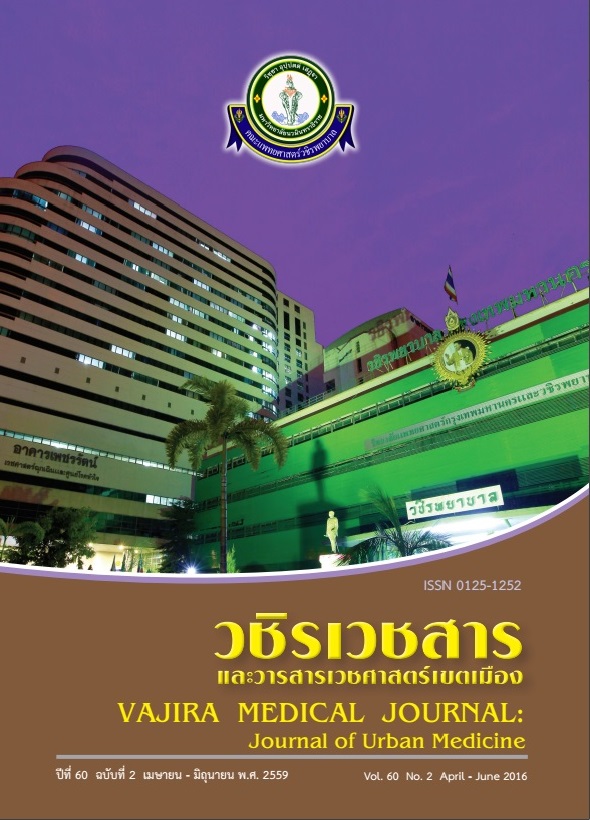Carbon Dioxide Absorbent
Main Article Content
Abstract
Nowadays, the breathing system in most of the anesthetic machine is “circle system” type which the unidirectional flow in the system passes through carbon dioxide absorbent; to prevent carbon dioxide from re-breathing in the next inhalation. Hence, the lower flow anesthetic is used, the higher quality of carbon dioxide absorbent is required. However, there have been several problems reported which are related to carbon dioxide absorbent such as heat generation in anesthetic circuit, melting of the absorbent cartridge, multiple sparking in the absorbent canister, re-breathing, air flow leakage in the circuit and acute respiratory distress syndrome. Therefore, knowing how to safely use each type of carbon dioxide absorbent is utterly important. The objective of this article is to compile the knowledge of chemical structure, risk versus benefit of each type of carbon dioxide absorbent, caution and problem during using carbon dioxide absorbent.
Downloads
Article Details
References
2. Hönemann C, Hagemann O, Doll D. Inhalational anaesthesia with low fresh gas flow. Indian J Anaesth. 2013; 57(4): 345-50.
3. Geoffrey Nunn BA. Low-flow anaesthesia. Contin Educ Anaesth Crit Care Pain. 2008; 8(1): 1-4.
4. WR Grace & Co - Conn. Sodasorb manual of carbondioxide absorption. 2nd ed. New York; 1993.
5. Venticinque SG, Andrews JJ. Inhaled anesthetics: delivery system. In: Miller RD, Eriksson LI, Fleisher LA, Jeanine P. Kronish W, Cohen NH, et al, editors. Miller’s anesthesia. 8th ed. New York: Churchill Livingstone; 2015; p.780 - 91.
6. Peters G, Broome I, McDonald A. Rebreathing after incorrect assembly of sodalime canisters on Blease Sirius anaesthetic machines. Anaesthesia. 2007; 62(8): 860-1
7. Parthasarathy S. The closed circuit and the low flow systems. Indian J Anaesth. 2013; 57(5): 516-24.
8. Yamamoto T. Cases of carbon dioxide rebreathing without significant color change in the appearance of the carbon dioxide absorbent canisters. J Anesth. 2013; 27(5): 807-8.
9. Ianchulev SA, Comunale ME. To do or not to do a preinduction check-up of the anesthesia machine. Anesth Analg. 2005; 101(3): 774-6.
10. Verma N, Toal P. High inspired carbon dioxide levels due to misplaced central tubing of the absorbent canister. Middle East J Anaesthesiol. 2013; 22(2): 237-8.
11. Agrawal P, Gupta B, D’souza N. An unusual cause of carbon dioxide rebreathing in a circle absorber system. J Anesth. 2010; 24(6): 976-7.
12. Nagelhout JJ, Elisha S, Plaus K. Nurse anesthesia. 5th ed. St. Louis, MO: Elsevier Saunders Company; 2014:p.271.
13. Holak EJ, Mei DA, Dunning MB, Gundamraj R, Noseir R, Zhang L, et al. Carbon monoxide production from sevoflurane breakdown: modeling of exposures under clinical conditions. Anesth Analg. 2003; 96(3): 757-64.
14. Laster M, Roth P, Eger EI. Fires from the interaction of anesthetics with desiccated absorbent. Anesth Analg. 2004; 99(3): 769-74.
15. Fatheree RS, Leighton BL. Acute respiratory distress syndrome after an exothermic baralyme -
sevoflurane reaction. Anesthesiology. 2004; 101(2): 531-3.
16. Castro BA, Freedman LA, Craig WL, Lynch C. Explosion within an anesthesia machine: Baralyme, high fresh gas flows and sevoflurane concentration.Anesthesiology. 2004; 101(2): 537-9.
17. Gonsowski CT, Laster MJ, Eger EI, Ferrell LD, Kerschmann RL. Toxicity of compound A in rats. Effect of increasing duration of administration. Anesthesiology. 1994;80(3):566-73.
18. Kandel L, Laster MJ, Eger EI, Kerschmann RL, Martin J. Nephrotoxicity in rats undergoing a one-hour exposure to compound A. Anesth Analg. 1995; 81(3): 559-63.
19. Laster MJ, Gong D, Kerschmann RL, Eger EI, Martin JL. Acetaminophen predisposes to renal and hepatic injury from compound A in the fasting rat. Anesth Analg. 1997; 84(1): 169-72.
20. Kharasch ED, Powers KM. Artru AA. Comparison of Amsorb® sodalime and Baralyme® degradation of volatile anesthetics and formation of carbon monoxide and compound a in swine in vivo. Anesthesiology. 2002; 96(1): 173-82.
21. Kondoh K, Atiba A, Nagase K, Ogawa S, Miwa T, Katsumata T, et al. Performance of a new carbon dioxide absorbent, Yabashi lime® as compared to conventional carbon dioxide absorbent during sevoflurane anesthesia in dogs. J Vet Med Sci. 2015; 77(8): 961-5.
22. Forman SA, Ishizawa. Inhaled Anesthetic Pharmacokinetics: Uptake, Distribution, Metabolism, and Toxicity. In: Miller RD, Eriksson LI, Fleisher LA, Jeanine P. Kronish W, Cohen NH, et al, editors. Miller’s anesthesia. 8th ed. New York: Churchill livingstone; 2015; p.638-69.
23. Kobayashi S, Bito H, Obata Y, Katoh T, Sato S. Compound A concentration in the circle absorber system during low-flow sevoflurane anesthesia: comparison of Drägersorb Free®, Amsorb®, and Sodasorb II®. J Clin Anesth. 2003;15(1):33-7.
24. Versichelen LF, Bouche MP, Rolly G, Van Bocxlaer JF, Struys MM, De Leenheer AP. et al. Only carbon dioxide absorbents free of both NaOH and KOH do not generate compound A during in vitro closed-system sevoflurane: evaluation of five absorbents. Anesthesiology. 2001; 95(3): 750-5.
25. Versichelen L, Bouche MP, Struys M, Van Bocxlaer J, Mortier E, de Leenheer AP, et al. Compound A production from sevoflurane is not less when KOH-free absorbent is used in a closed-circuit lung model system. Br J Anaesth. 2001; 86(3): 345-8.
26. Keijzer C, Perez RS, de Lange JJ. Compound A and carbon monoxide production from sevoflurane and seven different types of carbon dioxide absorbent in a patient model. Acta Anaesthesiol Scand. 2007; 51(1):31-7.
27. Higuchi H, Adachi Y, Arimura S, Kanno M, Satoh T. Compound A concentrations during low-flow sevoflurane anesthesia correlate directly with the concentration of monovalent bases in carbon dioxide absorbents. Anesth Analg. 2000;91(2):434-9.
28. Coppens MJ, Versichelen LF, Rolly G, Mortier EP, Struys MM. The mechanisms of carbon monoxide production by inhalational agents. Anaesthesia. 2006; 61(5): 462-8.
29. Baxter PJ, Garton K, Kharasch ED. Mechanistic aspects of carbon monoxide formation from volatile anesthetics. Anesthesiology. 1998; 89(4): 929-41.
30. Anders MW. Formation and toxicity of anesthetic degradation products. Annu Rev Pharmacol Toxicol. 2005; 45: 147-76.
31. Yamakage M, Takahashi K, Takahashi M, Satoh JI, Namiki A. Performance of four carbon dioxide absorbents in experimental and clinical settings. Anaesthesia. 2009; 64(3): 287-92.


